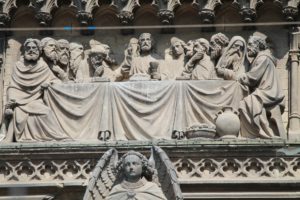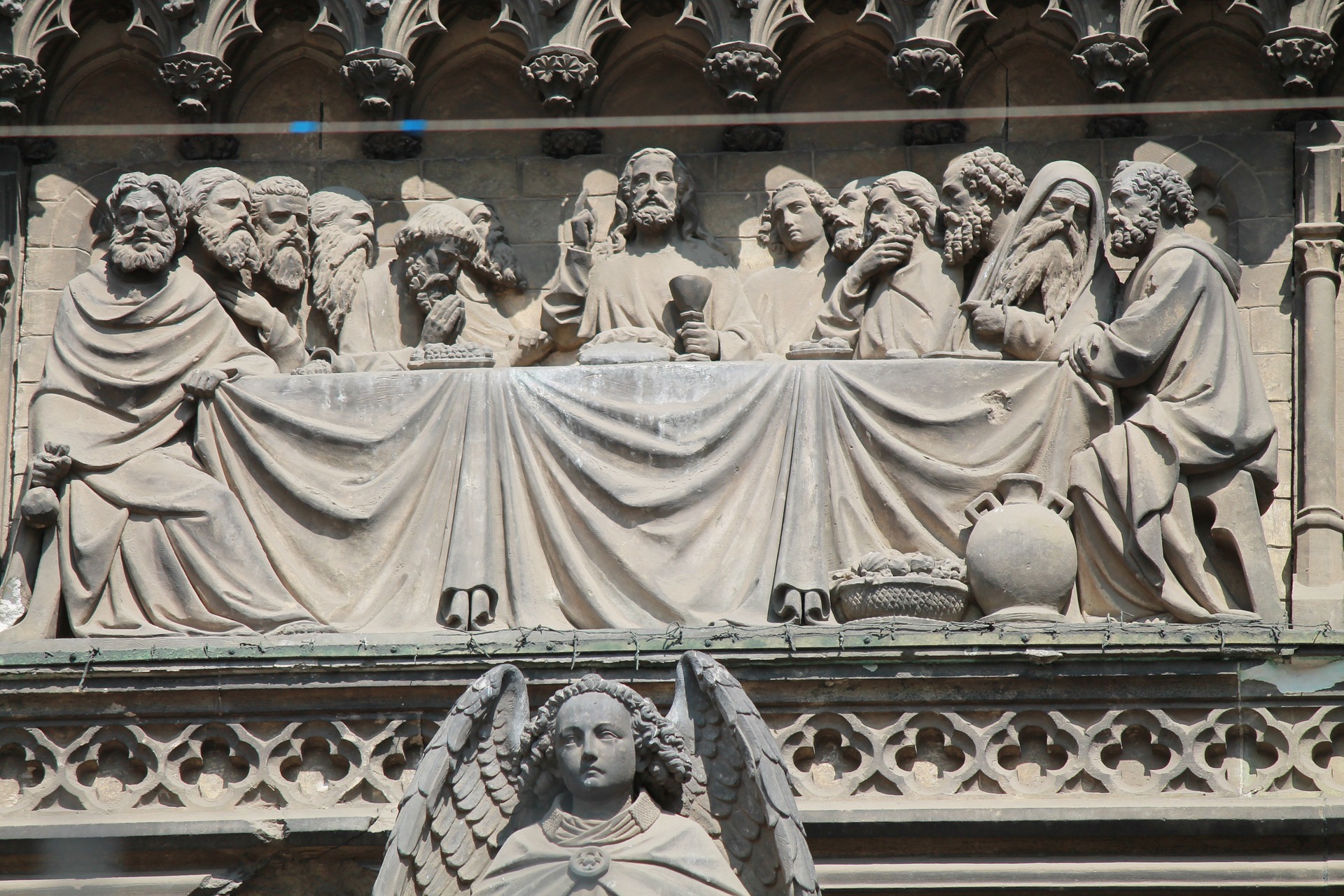 There been much tension regarding the Mass as both a meal and a sacrifice. A necessary corrective was introduced in the past twenty years to rectify the overly strong emphasis, heavily advanced during the 1970s and 1980s, on the Mass as a meal. The purpose of the corrective was to bring back needed balance with the root of the Mass: the cross and the overall paschal mystery.
There been much tension regarding the Mass as both a meal and a sacrifice. A necessary corrective was introduced in the past twenty years to rectify the overly strong emphasis, heavily advanced during the 1970s and 1980s, on the Mass as a meal. The purpose of the corrective was to bring back needed balance with the root of the Mass: the cross and the overall paschal mystery.
While we cannot dismiss the idea of the Mass as a meal, we must understand what sort of meal it is. When most people today hear the word “meal,” they do not think of a holy banquet or wedding feast, but more of an informal meal. And informality in American culture has become very informal indeed! We rarely dress up anymore; formal banquets, black-tie dinners, and the like are rare.
Thus our understanding of the Mass as a meal is colored by our culture’s informal definition, which is not intended in the Church’s understanding of the Mass. Permit, then, some of the following correctives:
I. The Mass is a meal, but it is no ordinary meal. The Mass is a sacred meal or banquet (Sacrum Convivium) and also the great Wedding Feast of the Lamb, for which one should be properly clothed (see Rev 19:6-9; Matt 22:12-13). This meal is not an informal one; it is a great banquet that should be esteemed and for which one should be prepared.
There are many people today who emphasize the “table fellowship” that Jesus had with sinners. They argue the Eucharist should be open to all, Catholic or not, saint or (even the worst) sinner. It is true that Jesus was often found at the table with sinners, where He ate with them.
But the Last Supper, at which the Eucharist was first given, was not just any meal; it was a Passover meal. The Passover meal was not an open one; it was a family meal and one rooted in the Jewish faith. People were instructed to celebrate this meal with their own families. And while several smaller or poorer families could come together for the meal, that was the exception rather than the norm.
Hence, the Last Supper is not to be compared to the open “table fellowship” Jesus had with sinners. Only the Apostles were formally gathered for the Last Supper.
So, to the extent that we can speak of the Mass as a meal, it is not an ordinary one with a “come-one, come-all” and/or “come as you are” mentality. It is not informal. It is a sacred meal that should be received worthily, celebrated with reverence, and which is integrally linked to the sacrifice of Jesus Christ on the cross.
Joseph Cardinal Ratzinger wrote substantially on this topic back in the late 1990s, and I presented and reflected on his writings here: Worthy Reception.
II. The Mass is not a reenactment of the Last Supper. It surely includes aspects of the Last Supper (most crucially the words of Institution of the Blessed Sacrament of the Eucharist).
But these aspects of the Last Supper are summarized and referenced, not reenacted. If it were truly a reenactment, then when the priest says that Jesus gave thanks, blessed and broke the bread, and gave it to them saying, “This is my body …”, he should send the host around immediately. And then when he takes the chalice and utters the words of consecration, he should tell all the people to drink from it immediately.
A literal reenactment might also require that we all recline on the floor on our left elbows at low, U-shaped tables. The Last Supper was not served at a modern, American-looking table, or even at one as Da Vinci imagined it. And perhaps the priest should recite the lengthy, priestly prayer of Jesus at the Last Supper, as recorded in John’s Gospel. Maybe a foot-washing should take place at every Mass. But even if we don’t absolutize the notion of reenactment, the point remains that the Mass is not a re-staging of the Last Supper.
Even at the Last Supper, in giving us the words of consecration Jesus points beyond the Last Supper itself. He says of the Bread, “This is my Body, which will be given up for you.” Thus He points beyond the meal to the cross. He says of the wine in the chalice, “This is the cup of my Blood, the Blood of the new and eternal Covenant, which will be shed for you and for many …” Here, too, He points beyond the meal itself to the cross.
Hence, while the connection of the Mass to the Last Supper is clear, it is not the only or even most important connection. The meal itself points to the sacrifice of Christ on the cross. And since at Communion we receive a living Lord (not a piece of dead flesh), the Mass also points to the resurrection.
III. When the priest speaks the words of Consecration at Mass, he is not addressing the congregation. This is another common point of confusion today. Not only is the Mass not a mere reenactment of the Last Supper, even when the priest speaks the words of Consecration at Mass, he is not addressing the congregation. These words, like all the words of the Eucharistic prayer, are directed to the Heavenly Father. They serve as a kind of basis and context for our sacrifice. When saying these words, the priest is speaking in the person of Christ and indicating that this act of our worship, as members of the Body of Christ, is united to the once-for-all, perfect sacrifice of Jesus on the Cross.
The essential point is that the words are directed to the Father. For a priest to gaze intently at the congregation and/or show the bread dramatically as he says the words of Consecration is to send the wrong signal, because it is not the people who are being addressed.
In the rubrics, the priest is directed to bow a little (parum se inclinat) as he says the words. He is not to be like an actor on a stage reenacting the Last Supper with all sorts of gestures and engagement of the faithful as if they were the Apostles. He is to bow as he speaks to the heavenly Father of what Jesus did and said in the institution of the Eucharist.
To reiterate, the entire Eucharistic Prayer is addressed to the Heavenly Father. Thus we are not “pretending” or reenacting the meal that was the Last Supper.
IV. What most makes the Mass a meal is the food that we receive. The food we receive is Jesus the Lord, who feeds us with His Body and Blood, Soul and Divinity. O sacrum convivium in quo Christus sumitur! (O Sacred Banquet in which Christ is received!) It is not necessary or even essential to engage in theatrics or to insist that the altar look like a simple, modern meal table (though noble simplicity has its place).
Thus the Mass is truly a meal as well as a sacrifice. But we must understand that the meaning of the word “meal” in the context of the Mass is distinct from some of our modern notions. It is a formal, sacred, exclusive meal for those of the household of faith who are in a state of grace. Proper attire and formality should be balanced with noble simplicity. And although the Last Supper is surely integral to the Mass, it is not merely reenacted; it is taken up in its essence (not merely in its external aspects), which points to the cross.


The Grandest of the grandest. That it is! The essence of our belief. The Source and Summit of our faith. Who would in one’s right mind will go to this event wearing just funny shorts like it is just one summer occasion. Goodness Gracious, come on, let us give GOD our best. YHWH EL GIBOR
When Jews sacrificed animals, apart from holocausts, they would eat the animal – just as Passover and its lamb show. A sacrifice was a holy rite, or sacrament, in Judaism, and it was offered for a purpose: so the Todah, or Eucharist, was offered for the purpose of giving God thanks for something.
Jesus fulfilled all the Jewish sacrifices, perpetuated the Todah, and now we share in His Sacrifice and Sacrament by Baptism and Confession, Confirmation and especially Communion: for the Eucharist is the Source and Summit of all the other sacraments as Christ, Who is their Source and Summit.
Jewish sacrificial meals weren’t just meals, so neither is the Mass.
Many thanks for the post. It makes me long for the realization of the strong suggestion by Cardinal Sarah for a return to the Mass being said Ad Orientem.
Of course the Last Supper was the particular time when Jesus ordained his apostles, priests, when he commanded them to do exactly what he had just done. He told them “Do THIS in memory of me”. Just what was that “THIS”? It was to take bread and to take wine and to change them, as he had changed them, into HIS Body and Blood. He gave them that power to work the miracles of changing bread and changing wine into HIMSELF.
This is indeed a most sacred moment!
And, of course, the congregation present at Holy Mass, are not given that power. Hence I do think that it is better for the priest to be turned towards God Himself, rather than towards the congregation when he utters the words of Consecration. But that is just my opinion.